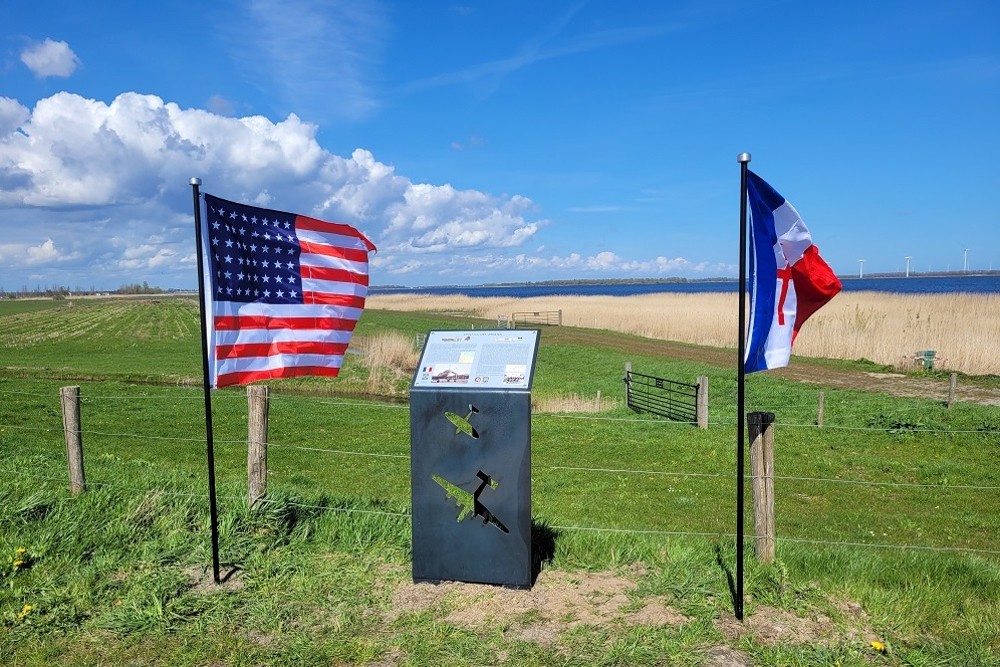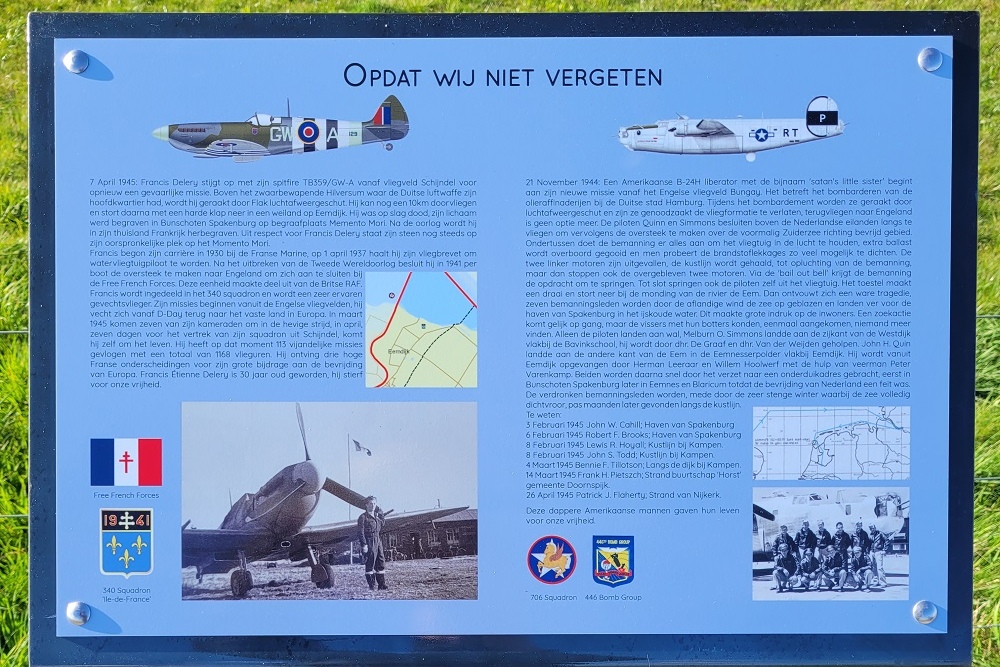War Memorial Fallen Aircrew Eemdijk
This memorial to Allied Soldiers of Worldwar II at Eemdijk was erected in memory of the crew members of an American B-24 bomber and a British Spitfire who died on November 21th, 1944 and April 7th, 19145.
On November 21th, 1944, an American B-24H Liberator, heavy bomber, nicknamed "satan's little sister",begins a new mission from the English airfield of Bungay. The mission involves bombing oil refineries near the German port city of Hamburg. During the bombardment over Hamburg they are hit by anti-aircraft fire and are forced to leave the flight formation, and turn back. Flying back to England is however no longer an option due to the damage sustained to the aircraft.
Pilots Quinn and Simmons decide to fly over the Dutch Wadd Isles to cross the former 'Zuiderzee' in the direction of liberated territory in the south of the Netherlands. The south of the Netherlands had already been partially liberated as of September 12th, 1944.
Meanwhile, the crew is doing everything possible to keep the plane in the air, ballast is thrown overboard and they are trying to plug the fuel leaks as much as possible. The two left engines have failed, the coastline is reached, to the relief of the crew, but then the remaining two right engines eventually also fail. Through the "bail out bell," the crew is ordered to jump. Then the pilots themselves also jump out of the plane.
The plane makes a turn and crashes at the mouth of the river Eem. Then a true tragedy unfolds, seven crew members are blown out to sea by the offshore wind and land far before the harbor of Spakenburg in the icy water. This made a great impression on the inhabitants. A search operation got underway right away, but the fishermen with their botters, once they arrived, could not find anyone. Only the two pilots landed on shore. Melburn O. Simmons landed on the side of the Westdijk near the Bavink school, he was resqued and helped by Mr. De Graaf and Mr. Van der Weijden.
John H. Quin landed on the other side of the Eem, in the Eemnesserpolder near Eemdijk. He was resqued and helped at Eemdijk by Herman Leeraar and Willem Hoolwerf with help from ferryman Peter Varenkamp. Both pilots are then quickly taken by the resistance to a hiding address. First in Bunschoten, Spakenburg, later in Eemnes and Blaricum. Waiting until the liberation of the Netherlands was a fact. The drowned crew members, partly due to the very harsh winter, when even the sea froze over completely, were not found along the coastline until months later.
CAHILL John W., found February 3th, 1945 near the harbor of Spakenburg; Technical Sargeant, age 21, buried in the American Cemetery at Margraten, plot J, row 1, grave 8.
BROOKS Robert F. found February 6th, 1945 near Spakenburg harbor; age 23, repatriated to the United States after the war and reburied there.
HOYALL Lewis R., found February 8th, 1945 near the shoreline near Kampen; Staff Sergeant, repatriated to the United States after the war and reburied there.
TODD John S., found February 8th, 1945 near the shoreline near Kampen; Sergeant, age 21, repatriated to the United States after the war and reburied there.
TILLOTSON Bennie F., found March 4th, 1945 along the dike near Kampen; Staff Sergeant, age 23, repatriated to the United States after the war and reburied there.
PIETSZH Frank H., found on March 14th, 1945 near the beach hamlet 'Horst' municipality of Doornspijk; Staff Sergeant, age 20, repatriated after the war to the United States and reburied there.
FLAHERTY Patrick J., found April 26th, 1945 near the beach at Nijkerk. Sergeant, age 23, reburied in the American Cemetery at Neuville-en-Condroz in Belgium in grave of plot B, row 40, grave 15
Remarkably, Technical Sargeant Cahill and Technical Sargeant Flaherty are not buried in the same cemetery despite both being recovered in the Netherlands. This can be explained because the cemetery at Neuville-en-Condroz, the Ardennes Cemetery, had a laboratory where much more research into the identity of a fallen soldier was possible. It is quite possible that no dog tag or other documents were found on Sargeant Flaherty by which he could be identified. His body will already have been in an advanced state of decomposition because he had been in the water for nearly 5 months. So after identification he was buried in this cemetery.
This is why this cemetery is arranged as a Latin cross. On all sides soldiers could still be buried after being identified here.
The text and letters BOMB GP (H) after the squadron on both headstones means Bombardment Group Heavy. Group heavy bombers.
Also remembered is French Spitfire pilot Francis Delery.
On April 7th, 1945, Francis Delery took off in his Spitfire TB359/GW-A from Schijndel airfield for another dangerous mission. Over heavily defended Hilversum, where the German luftwaffe had its headquarters, he is hit by Flak (FluggAbwehrKanone) anti-aircraft guns. He was able to continue flying for another 10km and then crashed with a loud crash into a meadow on Eemdijk and was instantly dead. His body was buried in Bunschoten, Spakenburg at the Memento Mori cemetery. After the war, he was reburied in his homeland of France. Out of respect for Francis Delery, his stone still stands in its original spot at the Momento Mori.
Francis Delery began his career in the French Navy in 1930, on April 1st, 1937, he obtained his pilot's license to become a seaplane pilot. In 1941, after the outbreak of World War II and the surrender of France, he decided to cross to England by boat to join the Free French Forces. This unit was part of the British RAF. Francis is assigned to the 340th squadron and becomes a very experienced fighter pilot. His missions begin from English airfields, he fights his way back to mainland Europe from D-Day. In March 1945, seven of his comrades were killed in fierce combat; in April, seven days before his squadron left Schijndel, he himself was killed. At that time he had flown 113 enemy missions with a total of 1,168 flying hours. He received three high French decorations for his great contribution to the liberation of Europe. Francis Étienne Delery lived to be only 30 years old.
On Friday afternoon, April 15th, 2023, the memorial was unveiled by Anne Hop, on behalf of and in the presence of pupils of the School with the Bible at Eemdijk and Alderman Peter van Asselt of the Municipality of Bunschoten, Spakenburg. Hereby the Initiator and and organizer, Wim Hop held a speech about the events on November 21th, 1944 and April 7th, 1945 in Eemdijk.
Do you have more information about this location? Inform us!
Source
- Text: Wim en Wieke Hop & Ed Lewandowski
- Photos: Wim en Wieke Hop (1, 2), Ed Lewandowski (3, 4)
Nearby
Museum
Point of interest
- Villa Mariaheuvel Baarn - Baarn
- Former Bath Hotel Baarn - Baarn
- Headquarters Sicherheitsdienst Baarn - Baarn
Monument
- War Memorial Spakenburg - Bunschoten-Spakenburg
- War Memorial General Cemetery Memento Mori Spakenburg - Bunschoten-Spakenburg
- Memorial May 1940 - Bunschoten-Spakenburg
Cemetery
- Dutch War Graves General Cemetery Memento Mori Spakenburg - Bunschoten-Spakenburg
- Dutch War Graves Roman Catholic Cemetery Blaricum - Blaricum
- Dutch War Graves Municipal Cemetery Blaricum - Blaricum
Remembrance Stone
- Stumbling Stones Bunschoterweg 41 - Nijkerk
- Memorial Stone Hamseweg 33 - Hoogland
- Stumbling Stone Prins Bernhardlaan 23 - Soest
Fortification
- Tank Barrier Spakenburg - Bunschoten-Spakenburg
- Grebbe Line - S3a Casemate E16 - Hoogland
- Grebbe Line - SZW Casemate E15 - Hoogland






